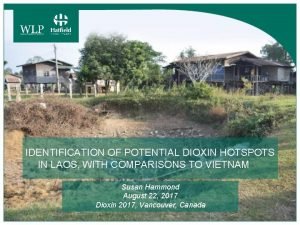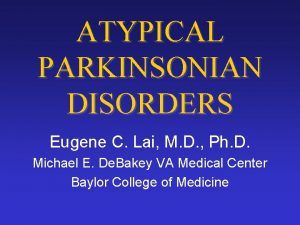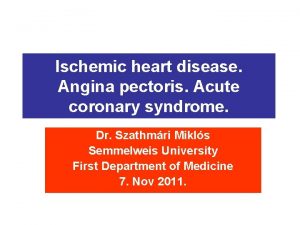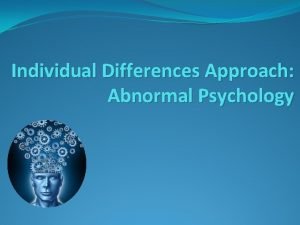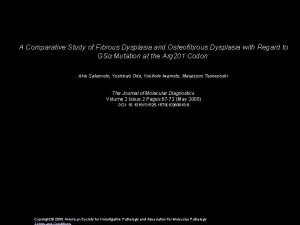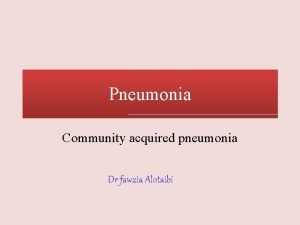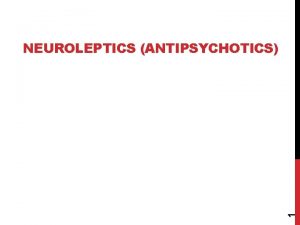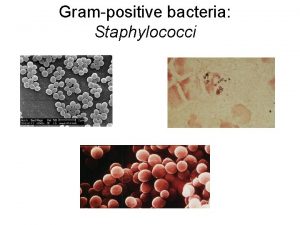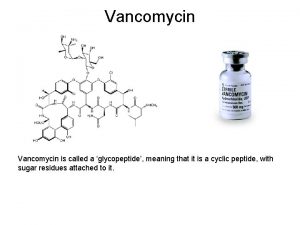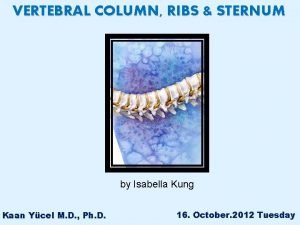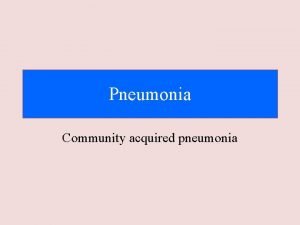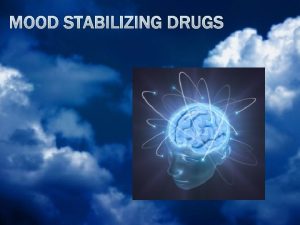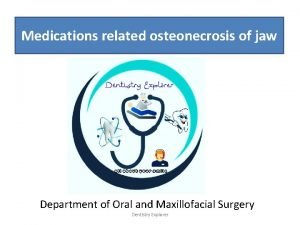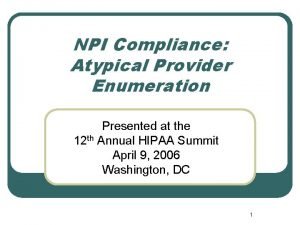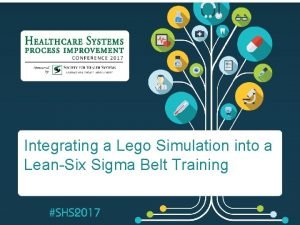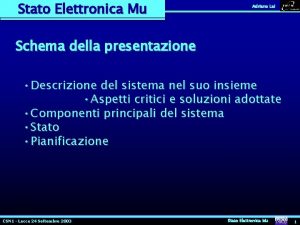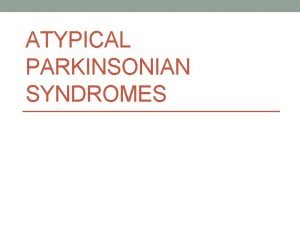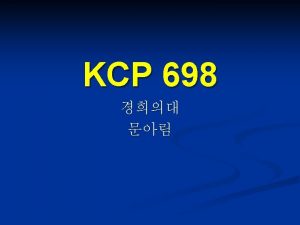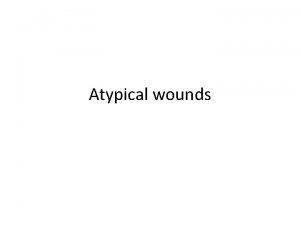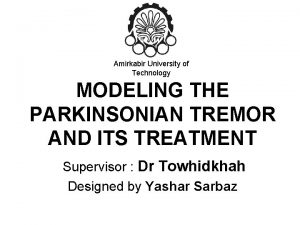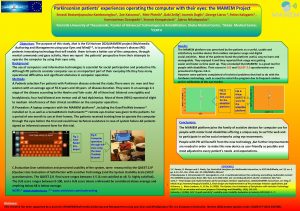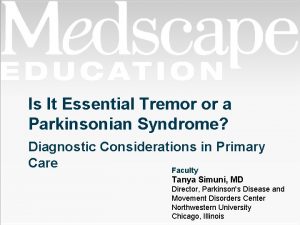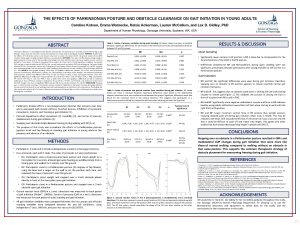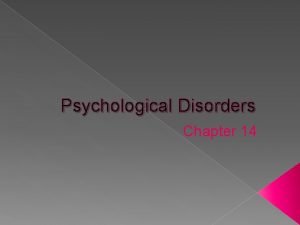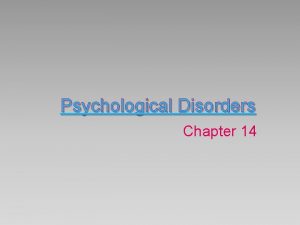ATYPICAL PARKINSONIAN DISORDERS Eugene C Lai M D







































- Slides: 39

ATYPICAL PARKINSONIAN DISORDERS Eugene C. Lai, M. D. , Ph. D. Michael E. De. Bakey VA Medical Center Baylor College of Medicine

PARKINSONISM akinetic-rigid syndrome

PARKINSONISM • Symptoms of Parkinson’s disease: • akinesia, bradykinesia, rigidity, postural instability, gait impairment, tremor A common, age-related syndrome ATYPICAL PARKINSONISM • Parkinson Plus Syndromes • Secondary Parkinsonism • Early falling, early dementia, early autonomic dysfunction

PARKINSON’S DISEASE General Considerations • The second most common progressive • • • neurodegenerative disorder The most common neurodegenerative movement disorder It is a complex disease with variable symptoms Symptoms and neuropathology are well characterized Pathogenesis of PD is not clear May be multifactorial and heterogeneous in etiology Misdiagnosis rate of PD is about 10 -25%





PARKINSON’S DISEASE Classical Clinical Features • Tremor, resting • Rigidity, cogwheel • Akinesia, bradykinesia • Postural Instability

PARKINSON’S DISEASE Associated Clinical Features • Micrographia • Hypophonia • Hypomimia • Shuffling gait / festination • Drooling • Dysphagia • Autonomic dysfunction • Depression • Dementia

PARKINSON’S DISEASE Features supporting diagnosis • Unilateral symptom onset • Characteristic resting tremor • Narrow-based gait with flexed/ • • stooped posture Reduced arm swing with tremor Sustained and significant levodopa effect

DISEASES ASSOCIATED WITH PARKINSONISM Sporadic Disorders • • • Parkinson’s disease Multiple system atrophy Dementia with Lewy bodies Progressive supranuclear palsy Corticobasal degeneration Prion diseases Amyotrophic-parkinson-dementia complex of Guam Pallidal degeneration Hemiatrophy hemiparkinsonism

DISEASES ASSOCIATED WITH PARKINSONISM • • • Hereditary Disorders Huntington’s disease Wilson’s disease Juvenile onset parkinsonism Hallervorden-Spatz disease Dentatorubropallidoluysian atrophy (DRPLA) Frontotemporal dementia with parkinsonism Hereditary prion diseases Lubag Machado-Joseph disease (SCA 3) Neuroacanthocytosis Type 3 GM 1 gangliosidosis

DISEASES ASSOCIATED WITH PARKINSONISM • • • Acquired Disorders Drug-induced parkinsonism Vascular parkinsonism Toxic parkinsonism Post-traumatic parkinsonism Post-encephalitic parkinsonism Prion diseases Extrapontine myelinolysis Space occupying lesions Hydrocephalus

PARKINSONISM AAN Practice Parameter Recommendations: Clinical features distinguishing other parkinsonian syndromes from PD • Falls at presentation and early in the disease • • • course Poor response to levodopa Symmetry at onset Rapid progression (to H&Y stage 3 in 3 years) Lack of tremor Early dysautonomia

THE BASAL GANGLIA • • • Consists of a group of nuclei in the deep part of the cerebrum and upper brain stem: caudate, putamen, globus pallidus, subthalamic nucleus, substantia nigra Coordinates muscle actions and voluntary movements Controls the higher-order, cognitive aspects of voluntary movement: the planning and execution of complex motor strategies Cognitive functions (procedural memory - skills & habits) Structural defects and neurotransmitter imbalance cause movement disorders: hypokinesia or hyperkinesia


ATYPICAL PARKINSONIAN DISORDERS • Multiple system atrophy • Dementia with Lewy bodies • Progressive supranuclear palsy • Cortical basal degeneration • Vascular parkinsonism • Drug-induced parkinsonism • Normal pressure hydrocephalus

NEURODEGENERATIVE PARKINSONIAN DISORDERS ALPHA-SYNUCLEINOPATHIES • Parkinson’s disease (PD) • Dementia with Lewy bodies (DLB) • Multiple system atrophy (MSA) TAUOPATHIES • Progressive supranuclear palsy (PSP) • Corticobasal degeneration (CBD)

ACQUIRED PARKINSONIAN DISORDERS • Vascular parkinsonism • Normal pressure hydrocephalus • Drug-induced parkinsonism

DEMENTIA WITH LEWY BODIES Clinical Features • Second most common form of degenerative • • dementia in old age Early psychotic symptoms: hallucinations/ delusions Mild extrapyramidal dysfunction Fluctuations in attention or level of arousal Orthostatic hypotension, syncope Depression Diurnal variations in behavior Neuroleptic sensitivity REM sleep behavior disorder

DEMENTIA WITH LEWY BODIES (Mc. Keith Criteria, 2005) • Probable DLB • Dementia • Two or more: marked fluctuations, typical visual hallucinations, parkinsonism • Possible DLB • Dementia • One of the following: marked fluctuations, typical visual hallucinations, parkinsonism • Specificity is high (>85%), but sensitivity is low

DEMENTIA WITH LEWY BODIES • Pharmacological Management Cholinesterase inhibitors: rivastigmine, donepezil – Multicenter, controlled, 20 -week study of rivastigmine (6 -12 mg/d) • • • No worsening of motor function Improvement of total Neuropsychiatric Inventory (NPI) score Improvement of 4 -item (delusion, hallucination, apathy, depression) subscore – Open-label study of donepezil Antipsychotic agents: – Neuroleptic sensitivity to typical antipsychotics – Low dose atypical antipsychotics are tolerated. quetiapine Dopaminergic therapy: – Carbidopa/levodopa Consider

MULTIPLE SYSTEM ATROPHY • • Clinical Features Prevalence of 2 -4 per 100, 000 population (may be underestimated) Median age of onset is 55 years (range 33 -76) Men : women = 1. 3 : 1 Mean survival 6 -9 years; half of pts disabled or WC bound within 5 years of onset of motor symptoms Autonomic dysfunction, cerebellar signs, parkinsonism, poorly or transiently responsive to levodopa therapy, sleep apnea or RBD, stimulus sensitive myoclonus Dysarthria, laryngeal stridor, anterocollis Not compatible with MSA: asymmetric sx, rest tremor, early dementia, prominent ophthalmoplegia, apraxia, cortical sensory loss Subtypes: Shy-Drager syndrome (MSA-A), striatonigral degeneration (MSA-P), olivopontocerebellar atrophy (MSA-C)

MULTIPLE SYSTEM ATROPHY Symptomatic Treatments • Levodopa for parkinsonian features • Sodium, fluid intake, pressure stockings, midodrine, • • fludrocortisone for orthostatic hypotension Oxybutinin or tolterodine for urinary frequency or incontinence Sildenafil for impotence Selective serotonin reuptake inhibitors for depression No good treatment of ataxia or dementia

PROGRESSIVE SUPRANUCLEAR PALSY • • • Clinical Features Prevalence of about 6 per 100, 000 population Median age of onset is mid-60 s, gradual sx onset Mean survival 5 -9 years; half of pts disabled or WC bound within 3 -4 years of onset of motor symptoms Parkinsonism, early instability with falls, poorly or transiently responsive to levodopa therapy, marked slowing of vertical gaze (esp. downward), eyelid apraxia, axial rigidity, retrocollis, motor perseveration Dysarthria, dysphagia, stuttering/palilalia early, laryngeal stridor Not compatible with PSP: asymmetric sx, rest tremor, early dementia, cortical sensory loss

PROGRESSIVE SUPRANUCLEAR PALSY (NINDS-SPSP CRITERIA) • PROBABLE PSP • a) Presence of a gradually progressive disorder • b) Onset at age 40 or older • c) Supranuclear limitation of vertical gaze AND a hx of prominent postural instability and falls in the first year of onset • d) No evidence of other diseases that can explain the above features • POSSIBLE PSP • a), b), and d) as above • c) Supranuclear limitation of vertical gaze OR a hx of prominent postural instability and falls in the first year of onset

CORTICAL BASAL DEGENERATION • • Clinical Features Prevalence of about 5 -7 100, 000 population Median age of onset is 60 s-70 s Mean survival about 7 years Insidious onset and progression of asymmetric cortical and basal ganglionic features Akinetic, rigid syndrome; hyperkinetic movement disorder (e. g. tremor, dystonia, myoclonus); alien limb phenomenon; speech impairment; gait disorder with postural instability; eye movement abn (slow horizontal saccades) Cortical dysfunction including dementia, apraxia, cortical sensory disturbance Not compatible with CBD - prominent ocular impairment, axial rigidity or dystonia out of proportion to limb involvement, rest tremor, autonomic failure, aphasia

PSP and CBD Clinical Features SIMILARITIES: • Relatively rapid disease progression • Speech and gait disturbance • Poorly or transiently responsive to levodopa therapy DIFFERENCES: • PSP - symmetric parkinsonism, vertical supranuclear gaze palsy, postural instability at onset and early falls, axial rigidity, wide-based/slow/unsteady gait • CBD - asymmetric parkinsonism, asymmetric cortical signs, dystonic posturing of unilateral limb, alien limb syndrome

PSP and CBD Pharmacological Treatments • Levodopa for parkinsonian features • Clonazepam for action tremor, myoclonus, and • • RBD Baclofen and tizanidine for rigidity, muscle spasms Botulinum toxin injection for limb dystonia and blepharospasm SSRI for depression, anxiety, pseudobulbar palsy Six-week, placebo-controlled, double-blind study of donepezil for PSP: modest improvement in memory test scores were offset by deterioration in functional mobility

CLINICAL DIFFERENTIATING OF PARKINSONIAN DISORDERS Symmetry of deficits Axial rigidity Limb dystonia Postural instability Vertical gaze restriction Frontal behavior Dysautonomia L-dopa response early L-dopa response late Asym cortical atrophy on MRI PD + +++ ++ -- MSA +++ ++ + + -- PSP +++ +++ +++ -+ --- CBD -++ ++ ---++

VASCULAR PARKINSONISM Clinical Features • Acute or subacute onset with stepwise evolution • • • of akinesia and rigidity Presence of risk factors for cerebrovascular disease Two or more basal ganglia infarcts OR more widespread subcortical white matter lesions evident on neuroimaging No rest tremor Prominent postural instability and gait disorder Unresponsive to levodopa treatment

VASCULAR PARKINSONISM Symptomatic Treatments • Control stroke risk factors • Keep active, stretching exercises • Physical therapy for leg strengthening • • and gait training Assistive devices Safety-proof living environment

NORMAL PRESSURE HYDROCEPHALUS • Syndrome of gait disturbance, urinary incontinence, and a dementing process • CT/MRI: ventricular enlargement disproportionate to cortical atrophy and smallvessel ischemic changes • Confirmed by beneficial response to largevolume cerebrospinal fluid drainage (30 -50 ml)

NORMAL PRESSURE HYDROCEPHALUS • Surgical treatment by CSF shunting procedure • Good prognosis is associated with presence of full triad, short duration of symptoms, mild dementia, lack of cerebral atrophy in combination with enlarged ventricles and intermittent CSF pressure elevations • Complications of shunt procedures include shunt malfunction, subdural hematoma, infection, seizure • Proper selection of patients and use of appropriate techniques are important for successful treatment

DRUG-INDUCED PARKINSONISM • Bradykinesia, rigidity, mild tremor, rabbit syndrome • Caused by exposure to a dopamine-receptor • • • blocking agent within 6 months of the onset of symptoms Offending drugs include: antipsychotics, antiemetics, metoclopramide Mild cases can frequently remit after cessation of the offending drug Usually unresponsive to dopaminergic therapy Elderly patients are most susceptible Treatment may include: tetrabenazine, reserpine, vitamin E, benzodiazepines

ATYPICAL PARKINSONIAN DISORDERS The differential diagnosis of atypical parkinsonian disorders is difficulty because there abundant overlapping features of the many disorders. Clinicians should be familiar with the less common but distinctive features of these disorders and have a high index of suspicion in order to tackle the diagnostic challenge, particularly in the early stages of disease. There is no reliable diagnostic markers available for the majority of the disorders.

RESOURCE INFORMATION • We Move • Lewy Body Dementia Association (www. lbda. org) • (204 West 84 th Street, New York, NY 10024; www. wemove. org) Provides worldwide education & information about all movement disorders. A place for LBD caregivers to meet and share through forum & educational materials • Shy-Drager Syndrome/Multiple System Atrophy Support Group (1 -866 -737 -4999; www. shy-drager-syndrome. org) Cure PSP (www. psp. org) A progressive supranuclear palsy support • Movement Disorder Society (www. movementdisorders. org) group international professional society of clinicians, scientists, and other healthcare professionals, who are interested in PD and related neurodegenerative and neurodevelopmental disorders An

PARKINSON’S DISEASE RESEARCH, EDUCATION, AND CLINICAL CENTER HOUSTON VA MEDICAL CENTER
 Kop chai lai lai
Kop chai lai lai Ted lai md
Ted lai md Chapter 26 fluid electrolyte and acid-base balance
Chapter 26 fluid electrolyte and acid-base balance Atypical workers
Atypical workers Typical vs atypical chest pain
Typical vs atypical chest pain Atypical behavior
Atypical behavior Atypical psychology definition
Atypical psychology definition Atypical cartilaginous tumor
Atypical cartilaginous tumor Atypical pneumonia
Atypical pneumonia Anhedonia synonym
Anhedonia synonym Dixycycline
Dixycycline Complex febrile seizure
Complex febrile seizure Atypicalfilms
Atypicalfilms Atypical bacteria
Atypical bacteria Substernal notch
Substernal notch Atypical pneumonia
Atypical pneumonia Atypical bacteria
Atypical bacteria Water balance regulation
Water balance regulation Atypical antipsychotics drugs
Atypical antipsychotics drugs Melanoma texture
Melanoma texture Atypical pneumonia
Atypical pneumonia Atypical odontalgia
Atypical odontalgia Npi compliance
Npi compliance Justina lai
Justina lai Iso 18404 training
Iso 18404 training Robert ho shai lai
Robert ho shai lai Ghép lãi nửa năm
Ghép lãi nửa năm Em tập lái ô tô lời bài hát
Em tập lái ô tô lời bài hát Tôi biết đấng nắm giữ tương lai
Tôi biết đấng nắm giữ tương lai Distributed global
Distributed global Adriano lai
Adriano lai Listen slowly summary
Listen slowly summary Mae lai village chiang mai
Mae lai village chiang mai Dừng chân nghỉ lại nha trang
Dừng chân nghỉ lại nha trang Lai-yang algorithm
Lai-yang algorithm Bài tập hợp đồng hoán đổi lãi suất
Bài tập hợp đồng hoán đổi lãi suất Chỉ tình thương ở lại
Chỉ tình thương ở lại Lai reua fai festival
Lai reua fai festival Mai lai massacre definition
Mai lai massacre definition Sale of goods act 1957
Sale of goods act 1957
